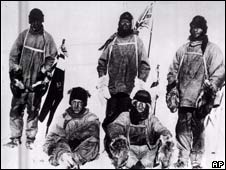Scott of the Antarctic Scott极地探险家
Scott of the Antarctic Scott极地探险家
The script from this programme:
Michelle: Hello and welcome to On the Town. I'm Michelle.
Helen: And I'm Helen.
收听与下载
Michelle: In today's programme, we'll be travelling to the deepest, darkest South Pole!
Helen: Hang on Michelle! We're not really going all the way to the South Pole. What we're actually doing is talking about an exhibition in London. 在伦敦有一个展览名为 Scott of the Antarctic. Scott 是一位著名的英国探险家,一百年前他带队去南极探险。
Michelle: Yes I got a bit overexcited! The exhibition in the Natural History Museum marks the 100th anniversary of Captain Robert Falcon Scott and his team making their epic journey to the South Pole.
Helen: Scott 的团队当年想成为第一支成功登陆南极的探险队,不过一组挪威探险队捷足先登。As you say Michelle, it was an epic journey 一段英雄旅程 but it was also a doomed one 结果很悲惨。
Michelle: Yes, it was doomed because after failing to reach the South Pole first, Scott and his team sadly died of exposure on their way back.
Helen: Scott 和他的团队在严寒、疲劳、饥饿和疾病的折磨下最终在回程路上先后死去。So the journey ended in tragedy 是悲惨的结局。
Michelle: And now one hundred years after the explorers' death, the Natural History Museum is telling their story in a special exhibition, called Scott's Last expedition. We're about to hear from museum curator Douglas Russell talking about Scott's journey, or as calls it, his "polar endeavour".

Captain Scott and his team
Helen: “南极奋进” 是博物馆对Scott 的极地探险的形容。And as we'll hear in this clip, Scott and his team had to face some very extreme conditions 极度恶劣的条件。
Douglas Russell: It's one of the most gallant stories in the history of Polar endeavour. Three men spent five weeks walking across Ross Island in Antarctica in pitch darkness. The temperatures that they endured were extraordinary. It's very difficult, I think, for most people to understand that it's your ability to function at those extraordinarily low temperatures.
Michelle: So did you catch some of the extreme conditions the curator described there Helen?
Helen: Yes he said that the men had to spend five weeks walking in pitch darkness 伸手不见五指。
Michelle: 'Pitch darkness' or as we sometimes say, 'pitch black' means no light at all. And did you hear how he described the temperatures in the South Pole?
Helen: He said that "the temperatures they endured" - 承受了– "were extraordinary" 极低温度。Brrr it's hard to even imagine how cold it must get in the Antarctic!
Michelle: Well did you know that apparently it was so cold that the men's teeth actually cracked!
Helen: 冷得连队员的牙齿都冻碎了。So how cold was it?
Michelle: Apparently temperatures dropped to minus forty degrees.
Helen: Wow! Minus forty degrees. 零下40度。That really is extraordinary!
Michelle: But even though we know Scott's endeavour to win the race to the South Pole ended in failure, the Natural History Museum wants to celebrate his achievements.
Helen: Yes, in fact while Scott and his team were in the Antarctic they collected a number of interesting scientific items. 他们采集了宝贵的科学样品。
Michelle: For example they collected rocks. And do you know what probably the most famous item they collected was Helen?
Helen: Yeah, I know this one. They collected emperor penguin eggs 帝王企鹅蛋。博物馆讲解员 Elin Simonson 说当时探险队想带回已经有了帝王企鹅胚胎的蛋 the penguin embryos inside the eggs.
Elin Simonsson: What they were going to do was to collect these penguin embryos, emperor penguin embryos. And they thought that maybe if you studied these embryos you might be able to find a link between birds and reptiles. But of course emperor penguins breed in the middle of Antarctic winters so you would have to go in the middle of the darkest Antarctic winter.

Captain Scott's diary has become famous
Helen: So the explorers were hoping to collect and study penguin embryos. 探险队员们希望能通过对企鹅胚胎的研究,看鸟类和爬行动物是否有关联。
Michelle: And also on display is some of the equipment Scott and his team used during their journey.
Helen: 让我们再听一下 Elin Simonsson 对探险队当年用的器材的介绍。她提到了队员当年穿戴的一样东西,你知道是什么吗?
Elin Simonsson: We also have the balaclava that Cherry-Garrard wore, and you can see how he attached a nose piece to the balaclava and he actually writes about it later, talking about how cold it was and he needed to protect his nose.
Michelle: So what was she describing there Helen?
Helen: She was talking about a balaclava. 巴拉克拉法帽,头耳朵脖子都可以被包起来。And it sounds like this one was specially made to protect the wearer's nose against the freezing weather. 探险队的巴拉克拉法帽是定做的,这样可以把鼻子也包起来。
Michelle: That's right. This balaclava was worn by an explorer called Cherry-Garrard who had joined Scott in some of his earlier journeys. So all these items go all the way back to 1912. But even one hundred years on, the story of Scott and his Antarctic expedition continues to live on.
Helen: Scott和他的团队极地探险事隔一百年,而他们的英勇精神还在不断的激励着人们。好,这期都市掠影节目就到这儿。您还可以在我们的网站上下载更多精彩节目 www.bbcukchina.com. 谢谢收听。 再见。
Michelle: Bye!